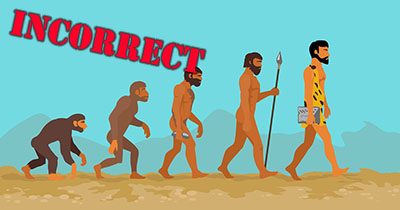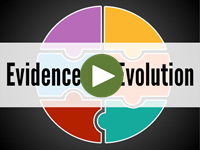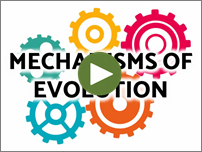The Theory of Evolution
 You may have seen some form of the image shown here because it has been widely featured on t-shirts and bumper stickers. While many people think that this 150-year-old 'monkey to man' graphic supports the theory of evolution, they are incorrect. The theory of evolution states that species change over time, and that through a variety of conditions they become different from their ancestors. Scientists do not believe that humans evolved from the apes you see today; instead, the theory of evolution supports the idea that apes and humans shared a common ancestor. Through changes to behavioral and physical traits that are passed down through reproduction, these two species diverged long ago.
You may have seen some form of the image shown here because it has been widely featured on t-shirts and bumper stickers. While many people think that this 150-year-old 'monkey to man' graphic supports the theory of evolution, they are incorrect. The theory of evolution states that species change over time, and that through a variety of conditions they become different from their ancestors. Scientists do not believe that humans evolved from the apes you see today; instead, the theory of evolution supports the idea that apes and humans shared a common ancestor. Through changes to behavioral and physical traits that are passed down through reproduction, these two species diverged long ago.
Evolution is about change, but not just any kind of change. Evolution specifically involves the genetic changes that occur in a species over time. All living things evolve due to these genetic changes, which result in traits that are inherited by successive generations within the population. Over time, a new species may emerge with a set of genetic traits unique from its ancestors. The mechanism for evolution is natural selection, a well-supported and testable scientific explanation of how evolution occurs.
Early Contributors to the Theory of Evolution
 Before you learn more about evolution and its mechanism of natural selection, you will need to examine how the theory came to be. While Charles Darwin is typically considered the "Father of Evolution," there have been many great thinkers and scientists who contributed to the theory throughout history. In this interactivity, learn more about each of these important figures. Click the player button to begin.
Before you learn more about evolution and its mechanism of natural selection, you will need to examine how the theory came to be. While Charles Darwin is typically considered the "Father of Evolution," there have been many great thinkers and scientists who contributed to the theory throughout history. In this interactivity, learn more about each of these important figures. Click the player button to begin.
View a printable version of the interactivity.
Darwin's Observations

Charles Darwin's notebook with
his first evolutionary tree
During his travels, Darwin filled scores of notebooks and sent thousands of specimens for further study back to England. He wrote in his journal that this time of exploration was the single most important time of his life. On the voyage back to England, he began to ponder those observed differences he noted on the Galapagos Islands. During this voyage, his theory on evolution started to take shape. Although a more lengthy biography about Charles Darwin and his revolutionary ideas is beyond the scope of this course, it is important to know that he struggled for some time before publishing in 1859 his idea on natural selection in the book, On the Origin of Species, due to concerns about how others might accept them.
Without much scientific knowledge of evolution, farmers of Darwin's time – as farmers had done for 10,000 years before – actively bred plants and animals for specific traits. For example, farmers bred certain horses to be very large and strong so they could pull heavy loads; farmers selectively bred species of corn and other seed crops that produced more bushels of seed per acre. Darwin pondered these selective breeding techniques while thinking about what happens naturally regarding variations of a species. This artificial selection by humans led Darwin to formulate his ideas about natural selection.
![]() Learn more about Darwin's journey, as well as the theory of evolution by natural selection, by viewing the video Evolving Ideas: Who Was Charles Darwin? from eMediaVASM. As you view the video, make note of what Darwin used as evidence to support his science.
Learn more about Darwin's journey, as well as the theory of evolution by natural selection, by viewing the video Evolving Ideas: Who Was Charles Darwin? from eMediaVASM. As you view the video, make note of what Darwin used as evidence to support his science.
Evidence of Evolution
 Like pieces of a large puzzle, the evidence supporting evolution fits together to create a picture showing the amazing development of species over time. There are six main types of evidence supporting evolution, including fossil records, the geographic distribution of related species, homologous structures, vestigial structures, similarities in embryology, and molecular biology. In this interactivity, explore the different types of evidence. Click the player button to begin.
Like pieces of a large puzzle, the evidence supporting evolution fits together to create a picture showing the amazing development of species over time. There are six main types of evidence supporting evolution, including fossil records, the geographic distribution of related species, homologous structures, vestigial structures, similarities in embryology, and molecular biology. In this interactivity, explore the different types of evidence. Click the player button to begin.
View a printable version of the interactivity.
Mechanisms of Evolution
A population is a group of reproducing organisms in a species who live in the same place and time. Due to the fact that they are linked, the organisms compete for resources, like food, water, shelter and mates. Because there are limits on the amounts of these resources, an environment can only support a certain number of offspring of any population.
 Evolution occurs through changes to a population's gene pool, or the collection of different genes in a population. There are five different mechanisms for evolution. In this interactivity, click on each of the gears to learn more about the mechanisms for evolution. Click the player button to get started.
Evolution occurs through changes to a population's gene pool, or the collection of different genes in a population. There are five different mechanisms for evolution. In this interactivity, click on each of the gears to learn more about the mechanisms for evolution. Click the player button to get started.
View a printable version of the interactivity.
The Theory of Evolution Review

![]() Now that you have learned about the theory of evolution and the evidence that scientists use to support it, review your knowledge in this non-graded activity. Read each question and select the appropriate answer. Then, click SUBMIT to check your response. Click the player button to get started.
Now that you have learned about the theory of evolution and the evidence that scientists use to support it, review your knowledge in this non-graded activity. Read each question and select the appropriate answer. Then, click SUBMIT to check your response. Click the player button to get started.